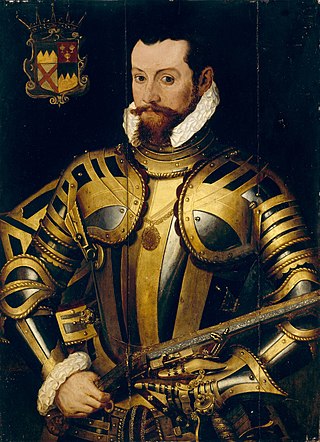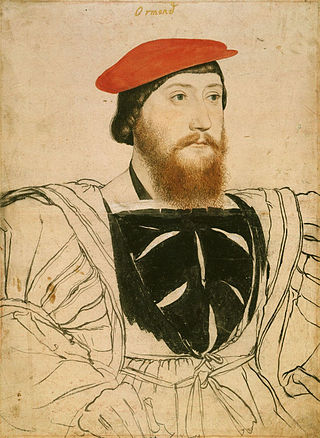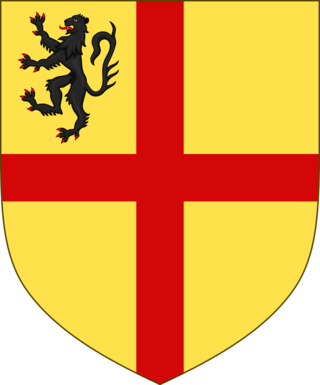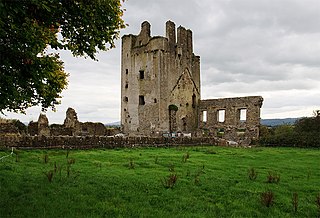
Thomas Butler, 10th Earl of Ormond and 3rd Earl of OssoryPC (Ire), was an influential courtier in London at the court of Elizabeth I. He was Lord Treasurer of Ireland from 1559 to his death. He fought for the crown in the Rough Wooing, the Desmond Rebellions, and Tyrone's Rebellion. He fought his rival, Gerald FitzGerald, 14th Earl of Desmond in the Battle of Affane in 1565.
David Fitz-James de Barry, 18th Baron Barry, 5th Viscount Buttevant (1550–1617), sided initially with fitz Maurice, the rebel, in the 1st Desmond rebellion but changed sides and fought against the rebels. He also fought for the crown in the Nine Years' War.
John Butler, 17th Earl of Ormonde, 10th Earl of Ossory (1740–1795) was an Irish peer and Member of Parliament (MP). He became a Protestant in 1764. He was an Irish MP, representing Gowran between 1776 and 1783, and Kilkenny City between 1783 and 1792. In 1791, his right to the peerage was acknowledged in the Irish House of Lords and he became the 17th Earl of Ormond.
Walter Butler (1703–1783), also known as Walter Butler of Kilcash, and Walter Butler of Garryricken, was the de jure16th Earl of Ormond and 9th Earl of Ossory. He did not assume these titles, as he thought them forfeit as a result of the attainder of the 2nd Duke of Ormonde. In the peerage of Ireland, the titles were successfully claimed in 1791 by his son John, the 17th Earl.
John Butler, known as John Butler of Kilcash, a member of the Irish landed gentry, was de jure15th Earl of Ormond and 8th Earl of Ossory. He did not assume these titles as he thought them forfeit by the attainder of the 2nd Duke of Ormond. He did, however, inherit the Ormond estate from the 1st Earl of Arran through Arran's sister Amelia. In 1791, the title of Earl of Ormond would be successfully claimed by his cousin, the 17th Earl.

Lieutenant-General Charles Butler, 1st Earl of Arran, de jure3rd Duke of Ormonde (1671–1758) was an Anglo-Irish peer. His uncle Richard was the 1st Earl of Arran of the first creation. The titles were re-created for Charles in 1693. His elder brother, the 2nd Duke of Ormonde, was attainted during the Jacobite rising of 1715, but in 1721 Arran was allowed to buy the estate back. At the death of the 2nd Duke, he succeeded as de jure 3rd Duke of Ormonde in the Irish peerage but did not claim the title.
Sir Walter Butler, 11th Earl of Ormond and 4th Earl of Ossory (1559–1633), succeeded his uncle Black Tom, the 10th earl, in 1614. He was called "Walter of the Beads" because he was a devout Catholic, whereas his uncle had been a Protestant. King James I intervened and awarded most of the inheritance to his uncle's Protestant daughter Elizabeth. Ormond contested the King's decision and was for that insolence detained in the Fleet Prison from 1619 until 1625 when he submitted to the King's ruling. He then found a means to reunite the Ormond estate, by marrying his grandson James, who had been raised a Protestant, to Elizabeth's only daughter.

James Butler, 9th Earl of Ormond and 2nd Earl of Ossory, known as the Lame, was in 1541 confirmed as Earl of Ormond thereby ending the dispute over the Ormond earldom between his father, Piers Butler, 8th Earl of Ormond, and Thomas Boleyn, 1st Earl of Wiltshire. Butler died from poison in London.
John Butler, Earl of Gowran (1643–1677) was an MP in the Irish Parliament 1661–1666 before being created Earl of Gowran in 1676. He married but died childless.
Christopher Plunket, 2nd Earl of Fingall and 11th Baron Killeen was an Irish politician and soldier. In 1641 he negotiated with the rebels on behalf of the Old English of the Pale and pushed them to join the rebellion. He fought for the rebels at the siege of Drogheda. He joined the Confederates and fought in their Leinster army, notably at Dungan's Hill. When the Confederates fused into the Royalist Alliance, he fought under James Butler, 1st Duke of Ormond in the Battle of Rathmines where he was wounded and taken prisoner. He died of his wounds two weeks later in captivity at Dublin Castle.

William Burke, 7th Earl of Clanricarde, PC (Ire), was an Irish peer who fought in his youth together with his brother Richard, 6th Earl of Clanricarde under their cousin, Ulick Burke, 1st Marquess of Clanricarde against the Parliamentarians in the Cromwellian conquest of Ireland. He succeeded his brother as the 7th Earl in 1666.

Kilcash Castle is a ruined castle off the N24 road just west of Ballydine in County Tipperary, Ireland. It is in the care of the Irish State. The Butler dynasty has important links to the area.

John Butler of Kilcash was an Irish landowner and soldier. A younger son of James Butler, 9th Earl of Ormond and brother of Thomas Butler, 10th Earl of Ormond, he received Kilcash Castle as appanage. He fought in the Desmond–Ormond conflict and was badly wounded in 1563, just before the Battle of Affane. He was the start-point of the Kilcash branch of the Ormonds and the father of Walter Butler, 11th Earl of Ormond.
Thomas Butler, Viscount Thurles was the son and heir apparent of Walter Butler, 11th Earl of Ormond (1559–1633), whom he predeceased. He lived at the Westgate Castle in Thurles, County Tipperary. He was accused of treason but drowned in a shipwreck off the Skerries in the Irish Sea, before he could be judged. He was the father of the Irish statesman and Royalist commander James Butler, 1st Duke of Ormonde.
Richard Butler of Kilcash (1615–1701) was an Irish soldier and landowner, the third son of Thomas Butler, Viscount Thurles and brother of James, 1st Duke of Ormonde. He sided with the Irish Confederacy at the Irish Rebellion of 1641. He scouted the enemy on the morning of the Battle of Cloughleagh. His descendants succeeded to the earldom of Ormond when the senior branch of the family failed in 1758.
Cormac na Haoine MacCarthy Reagh, 13th Prince of Carbery (1490–1567) was an Irish chieftain who owned almost half a million acres in south west Ireland.

Elizabeth Poyntz (1587–1673), known as Lady Thurles, was the mother of the Irish statesman and Royalist commander James Butler, 1st Duke of Ormonde.
Helen Burke, Countess Clanricarde, also styled Helen FitzGerald, was brought to France by her mother fleeing the Cromwellian conquest of Ireland, against which her father, the 2nd Earl Muskerry, resisted to the bitter end. In France, she was educated at the abbey of Port-Royal-des-Champs together with her cousin Elizabeth Hamilton. She married three times. All her children were by her second husband, William Burke, 7th Earl of Clanricarde. She was the mother of Ulick Burke, 1st Viscount Galway, Margaret, Viscountess Iveagh, and Honora Sarsfield.
Margaret Magennis, Viscountess Iveagh, also known as Margaret Butler, was the mother of John Butler, the de jure 15th Earl of Ormond. She is remembered by the song A Lament for Kilcash.
Luke Plunket, 3rd Earl of Fingall (1639–1684) was an Irish soldier and politician. He was one of the signatories of the Catholic Remonstrance of 1661.







